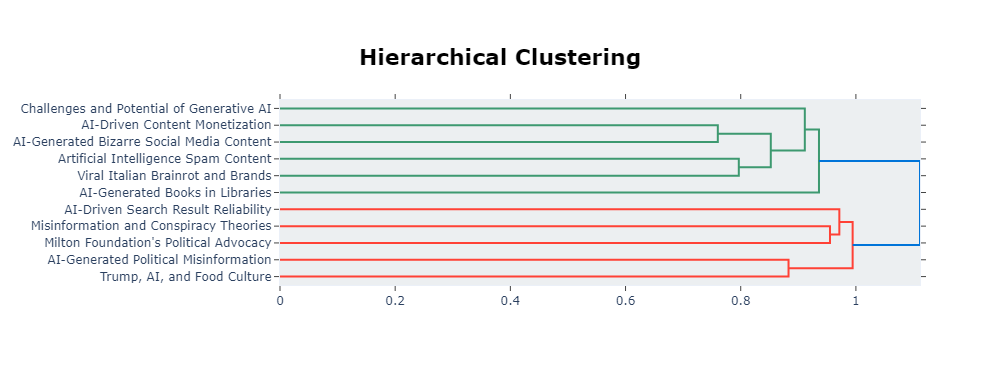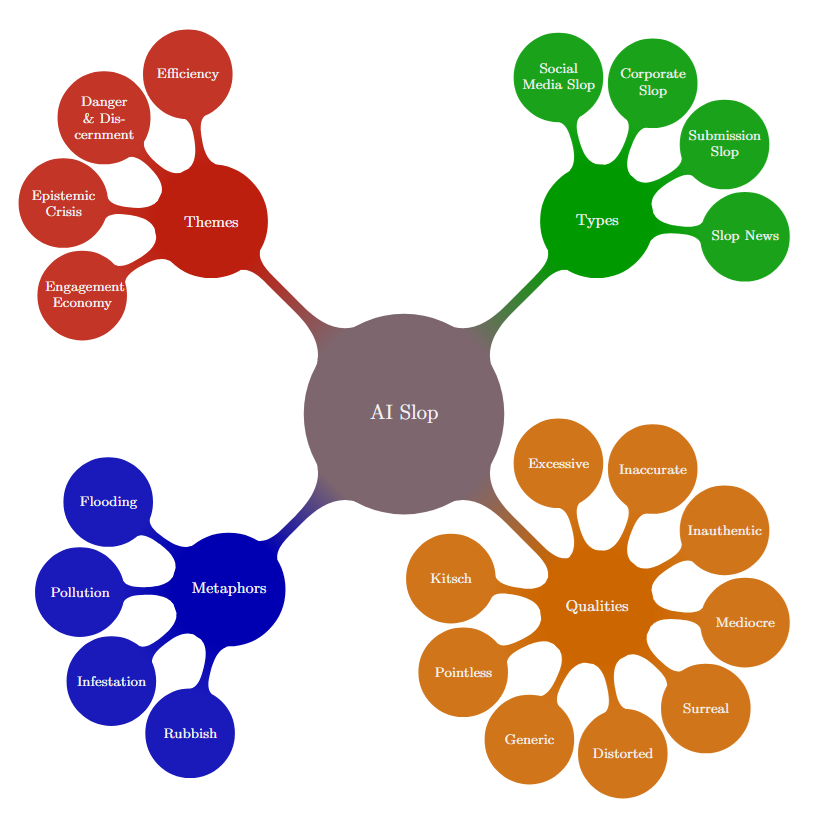One of the most salient features of our culture today is that there is so much slop. Each of us has been subjected to this; each of us contributes their share. But what even is AI slop?
To investigate this, I:
- Conducted qualitative and quantitative analyses of sources referenced in the Wikipedia page on AI slop. From these, I construct four dimensions for slop: themes, types, qualities, and metaphors.
- Created the SlopNews dataset, used to analyse the statistical features of slop content. Compared to non-slop news, slop news is less complex, less varied, and has more positive sentiment.
- Created an archive (slopscooper) where I collect examples and publications about AI slop.
This is a synthesized version of my Master's dissertation. To read the whole thing, click here.
This is the second part of a series on AI slop. This part investigates what people say about slop. The first post goes into the contextual information and theoretical aspects (history, philosophy, media theory) of slop. The third post analyses the quantitative aspects slop itself.
Thematic analysis is a widely adopted qualitative method for identifying patterns of meaning across a dataset (Braun & Clarke, 2006 --- fun fact: this is one of the most cited papers of all time, with around 120,000 citations). The dataset consists of 34 articles cited by the Wikipedia page on AI slop (the full list is on the dissertation). Content was collected using Trafilatura and coded using Taguette. Doing this, I identified the themes, metaphors, qualities and types of slop.
Themes of slop
- Efficiency and productivity: Slop is generated due to its low cost, speed, ease of creation, and scalability. This applies to corporations aiming to cut costs and individuals seeking side income. These indicate a significant incoming shift in several industries, which is accompanied by concerns about the automation of creative labour.
- Danger and discernment: The excess of slop overwhelms information systems and creates the need for its filtering and moderation. This is especially challenging since slop does not strictly violate platform policies. This is threatening both to institutions and to individual users, who might unknowingly be exposed to false information.
- Epistemic crisis: Slop is related to moral anxieties about political disinformation, the “post-truth” environment, and the wider breakdown of shared reality and trust in institutions.
- Engagement economy: Platform incentives (such as engagement, virality, and ad revenue), which are ultimately about profit, are the primary drivers of slop. Individuals in low-income regions are especially incentivised to engage in its creation.
Here are some example quotations from the dataset (all this information is public; see the dissertation for specific references):
It’s easy to learn, almost zero cost, and can be done any time at home with just a phone. (efficiency and productivity)
But the slop tide threatens some of the key functions of the web, clogging search results with nonsense, overwhelming small institutions [. . . ], and generally polluting the already fragile information ecosystem of the internet. (danger and discernment)
AI slop more broadly is poisoning the internet and is destroying the last shred of any sense of reality or reliability of social media platforms and search engines. (epistemic crisis)
Just like spam, almost no one wants to view slop, but the economics of the internet lead to its creation anyway. (engagement economy)
In comparison, some themes had surprisingly low prevalence in the dataset, such as: general AI risks (model collapse, guardrails, copyright, environmental cost, existential risk, plagiarism), positive slop (e.g. as art or humour), and other hyped technologies (e.g., cryptocurrency, NFTs).
Qualities of slop
- 💥 Excessive: Everywhere, clutter, spam, river, vast quantities, churn, glut.
- ❌ Inaccurate: Wrong, hallucinated, misleading, nonfactual, cartoonishly false.
- 🎭 Inauthentic: Lifeless, voiceless, inhuman, meaningless, purposeless, unnatural.
- 😐 Mediocre: Low-quality, low-grade, shovelware, low-effort, cheap, shoddy.
- 🌀 Surreal: Surreal, uncanny, bizarre, unsettling, gobbledygook, nonsense.
- 🪞 Distorted: Distorted, warped, deformed, fingers.
- 📦 Generic: Generic, filler, repetitive, unoriginal, banal, flat.
- 🫥 Pointless: Inconvenient, inoffensive, irrelevant, contextless, unneeded.
- 🦄Kitsch: Kitsch, shlock, loud, messy, amateurish, corny, manipulative.
The outcome of the proliferation of slop is the drowning out of intention, meaning, and effort; words like intentionality, depth, creativity and value are invoked as slop’s opposites. Some terms didn’t consolidate into qualities but recur: disrespectful, inconvenient, inoffensive, and good. Many qualities – like kitsch, surreal, excessive – tie back to “weird AI crap” on Facebook, while others – inauthentic, inaccurate, generic – are more relevant to other types of slop such as submission slop and slop news (see below).
Metaphors of slop
- 💧 Deluge: flood, clogging, deluge, wade through, stream, drowning, rising tide, swamp.
- 🏭 Contamination: pollution, scrubbing, ecological footprint, poison, chokes, contamination.
- 🌱 Infestation: spreading, proliferation, propagation, grow wildly, mulch, weeding out.
- 🗑️ Dross: trash, rubbish, garbage, dross, crap, junk, drivel.
The discourse around slop is highly metaphorical, embodied and affective. These metaphors show themes of flooding (water and overabundance), contamination (pollution and toxicity), infestation (unchecked spread and infiltration) and rubbish (worthlessness and clutter). In these we find the emotional aspects of slop: its dirtiness, excess, vacuity and threat. Among these, the most dominant idea is flooding.
Language about slop is not only metaphorical, but displays a characteristic sound symbolism. Words related to slop share a kind of sludgy phonosemantics: mulch, glut, churn, chum, spam, etc. Other related concepts that share metaphorical aspects of excess, inauthenticity, and intrusiveness include:
- pink slime: inauthentic media content
- slush pile: unsolicited manuscripts
- vendor slurry: library slop
- grey goo: self-replicating nanobots
Slop also has a kinetic quality. Through the water metaphor, it is related to flowing water, or to clogging information flow. Through infestation, it spreads—undesirable, everywhere. Other minor metaphorical resonances identified include: inconvenient but not threatening (“clutter”), mechanical or inhuman (“churn out”, “noise”), vacuity (“drivel”), excess (“glut”) and undesirable food (“unappetizing”).
Types of slop
- Social media slop: Low-effort or manipulative engagement bait created by sloppers for profiting on social media platforms. Primarily identified by its surreal and kitschy appearance.
- Corporate slop: Low-quality AI-generated media used by corporations for cost-cutting purposes, typically in advertising. Primarily identified through its distorted quality, signalling inauthenticity and lack of effort.
- Submission slop: Papers, books, applications, and other media mass-submitted to overwhelm selection systems. Identified by its excess, inaccurate information where accuracy is essential, and by being generic or mediocre in other contexts.
- Slop news: Low-quality news articles created by professional sloppers for SEO manipulation instead of human readership. Identified by being generic and pointless compared with news written for human consumption.
Here are some example quotations from the dataset:
Amputee kittens using crutches. Strawberries in the shape of lifelike frogs. Bosomy conjoined twins, structurally impossible sand sculptures, snakes swallowing fully-grown lions, airplanes with human hands. An underwater Jesus covered in shrimp. (social media slop)
A thumbnail image for 12 Angry Men on Amazon Freevee used AI to depict 19 men with smudged faces, none of whom appeared to bear any similarities to the characters in the film. (corporate slop)
Identical Viking ‘novels’ with seemingly AI-generated covers, all called Wrath of the Northmen: A Gripping Viking Tale of Revenge and Honor (that one has been published variously by authors named Sula Urbant, Sula Urbanz, and Sula Urbanr). (submission slop)
This is not an exhaustive list. Other examples could include summarization hallucinations—like “Google suggesting that you could add nontoxic glue to make cheese stick to a pizza? That’s slop”—as well as politically motivated disinformation, such as “Kamala Harris did not give a speech at the Democratic National Convention to a sea of communists while standing in front of the hammer and sickle”. However, these cases are better addressed under established categories (hallucination and disinformation, respectively). Similarly, the fake events in this dataset resulted from low-effort SEO hacking and are not necessarily related to AI.
Slop is often economically motivated, closely tied to advertising, cost-cutting, propaganda, and scams. Advertising, in particular, plays a central role. Prominent examples include corporations generating AI-produced ads and assets, as well as individual “sloppers” creating viral images for engagement.
Visually, slop is most recognizable in image-based content. This is likely due to the ease with which artifacts—distorted anatomy, surreal ideas—can be identified, particularly in social media and corporate contexts. For examples of social media slop images, see the Ai Boomertrap (TM) Facebook group and the Insane Facebook AI Slop subreddit.
Topic modelling
Thematic analysis has an analogue in natural language processing called topic modelling. Since TF-IDF + LDA doesn't give particularly interesting results, I used bertopic, which streamlines a more elaborate topic modelling pipeline. I stuck to their best practices documentation; the only difference is that I used text-embedding-3-large for embeddings and gpt-4.1-nano for representation.
Standard hyperparameters (HDBSCAN min_cluster_size=150) yields around 80 topics. After qualitative interpretation of those, I constructed the following topics:
- AI-generated assets: content created for media (games, films, ads) using AI.
- Fake or low-quality events: problematic public events advertised with AI-generated content.
- Low-quality digital content: spam, surreal slop, SEO-focused content, ad monetization, and moderation issues.
- Information and politics: misinformation, political narratives, media influence, public belief, and the epistemic crisis.
By setting min_cluster_size to 18 we get around 10 topics. Only one was directly related to AI slop, so I discarded all the other topics and ran the model again on the relevant subset of the data. The resulting topics are very similar to the themes constructed in the thematic analysis.


Asking ChatGPT
While this might sound like a lazy cop-out, using LLMs as classifiers is legitimate suggestion from the misinformation detection literature (Chen & Shu, 2024). In fact, they claim it has state-of-the-art performance.
I used Gemini 2.5-Pro through the Google AI Studio interface. After a very simple prompt and another one to summarize to a bullet point list (see dissertation for details), we get:
- Defining Traits - Low Quality and Uncanny: Slop is defined by its poor quality, visual flaws, nonsensical text, and a “soulless” or cheap feel that betrays its non-human origin.
- Motivations - Profit, Speed, and Scale: The creation of slop is driven by economic incentives such as engagement farming and corporate cost-cutting.
- Impact and Consequences - Deception and Real-World Harm: Slop has tangible negative effects, such as fake events, misinformation, and political propaganda.
- The ‘Slop’ Framework - A Polluted Information Ecosystem: Slop is a symptom of a “post-truth” sociotechnical environment where digital pollution erodes public trust and blurs the lines between truth and fiction.
Interpretation
We compare four approaches:
- manual thematic analysis,
- traditional topic modelling using TF-IDF
- a more elaborate topic modelling approach using bertopic
- and an LLM-based approach which I thought it would be funny to call “thematic modelling.”
They all provided similar results, strengthening confidence in the findings. While not ground-breaking, the qualitative findings provides future work a systematic framework to talk about AI slop.
What merits attention here are the results of the thematic modelling. In a single five-second query, I produced results comparable to a five-hour quantitative analysis and a five-day qualitative analysis.
The LLM-based approach outperformed the topic modelling methods. For this small dataset, the generated topics were cheaper, easier, more interpretable, and more nuanced than traditional topic modelling, which focused on named entities or tangential events. It produced more relevant, abstracted topics (e.g., “Defining Traits - Low Quality and Uncanny”) while topic modelling produced more concrete topics (e.g., “Viral Italian Brainrot and Brands”). Moreover, it was free, fast, and easy to implement.
The LLM-generated themes are remarkably similar to my detailed and painstakingly coded thematic analysis. However, it remained grounded in descriptive surface patterns, whereas my manual analysis was more interpretive and, arguably, more meaningful. While there are short-term benefits for the analysis at hand, it might result in long-term institutional harms by reducing a researcher’s engagement with their subject matter. This was something I experienced.
While the LLM’s strict adherence to the provided instruction can be a desirable trait, it lacks the contextual understanding of a human researcher. A human might question a flawed premise, whereas the LLM will always oblige. Its output should be treated as a classification that requires human interpretation (much like traditional topic modelling). Care should also be taken with terminology; these are not the “LLM’s interpretations,” but the results of a “LLM-based method.”
This work investigated AI slop—its qualities, metaphors, themes, types. Slop is described as excessive, inaccurate, inauthentic, mediocre, surreal, distorted, generic, pointless, and/or kitschy. It is enabled by cheap, scalable automation which is used to respond to the incentives of the engagement economy. AI slop floods digital spaces with low-effort, contextless, generic, and/or surreal material. It is created for productivity, profit, or manipulation rather than meaningful communication.
Here is a helpful graphic summarizing this part of the research:

Continue reading on the third part, where we do some actual math and analyse slop itself.
If you would like to be notified whenever I release more stuff like this, sign up here.

